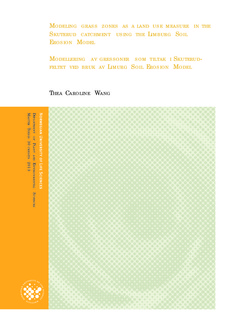| dc.contributor.author | Wang, Thea Caroline | |
| dc.date.accessioned | 2013-09-05T11:13:23Z | |
| dc.date.available | 2013-09-05T11:13:23Z | |
| dc.date.copyright | 2013 | |
| dc.date.issued | 2013-09-05 | |
| dc.identifier.uri | http://hdl.handle.net/11250/189619 | |
| dc.description.abstract | The frequency and intensity of rain events are expected to increase in the future, causing excess surface runoff and flooding situations in many areas. Hydrological models can be used to assess the impact of implemented conservation measures and guide decision-makers within the context of land use planning. At the same time, the value of models is highly dependent on the accuracy of predictions and sufficient understanding of model processes. For this study, the hydrological and soil erosion model LISEM has been used to investigate the modeling of grass strips as a land use measure in the Skuterud catchment in Ås, Norway. The main focus has been on evaluating modifications of the input parameters and analyzing the effect of spatial extent and placement on total discharge and peak discharge. The grass strips were modeled for three different locations within the catchment, and three rain events of various magnitudes were simulated.
The main results from the simulations show that: For small to moderate rain events the model simulates that a single measure downstream in the catchment along the main water channel is the most effective in reducing total discharge and peak discharge; it is the placement in the catchment rather than the size of the measures that defines the effect; for events with increased precipitation intensity the variation between the effect of the simulated measure is reduced; although flow properties respond similarly for all approaches when rain intensity increases, there are large variations in simulated soil loss between the approaches.
The simulation outcomes demonstrate some of the complexities of quantifying surface runoff within the model. The results of the analysis suggest that flow velocity, rainfall intensity and placement of measures are important factor when modeling watershed runoff with the LISEM model. | no_NO |
| dc.language.iso | eng | no_NO |
| dc.publisher | Norwegian University of Life Sciences, Ås | |
| dc.subject | LISEM | no_NO |
| dc.subject | grass zones | no_NO |
| dc.subject | modeling | no_NO |
| dc.subject | surface runoff | no_NO |
| dc.title | Modeling grass zones as a land use measure in the Skuterud catchment using the Limburg Soil Erosion Model | no_NO |
| dc.title.alternative | Modellering av gressoner som tiltak i Skuterud-feltet ved bruk av Limburg Soil Erosion Model | no_NO |
| dc.type | Master thesis | no_NO |
| dc.subject.nsi | VDP::Technology: 500::Environmental engineering: 610 | no_NO |
| dc.subject.nsi | VDP::Mathematics and natural science: 400::Geosciences: 450::Hydrogeology: 467 | no_NO |
| dc.source.pagenumber | 77 | no_NO |
| dc.relation.project | Norsk forskningsråd: 200678 | no_NO |
